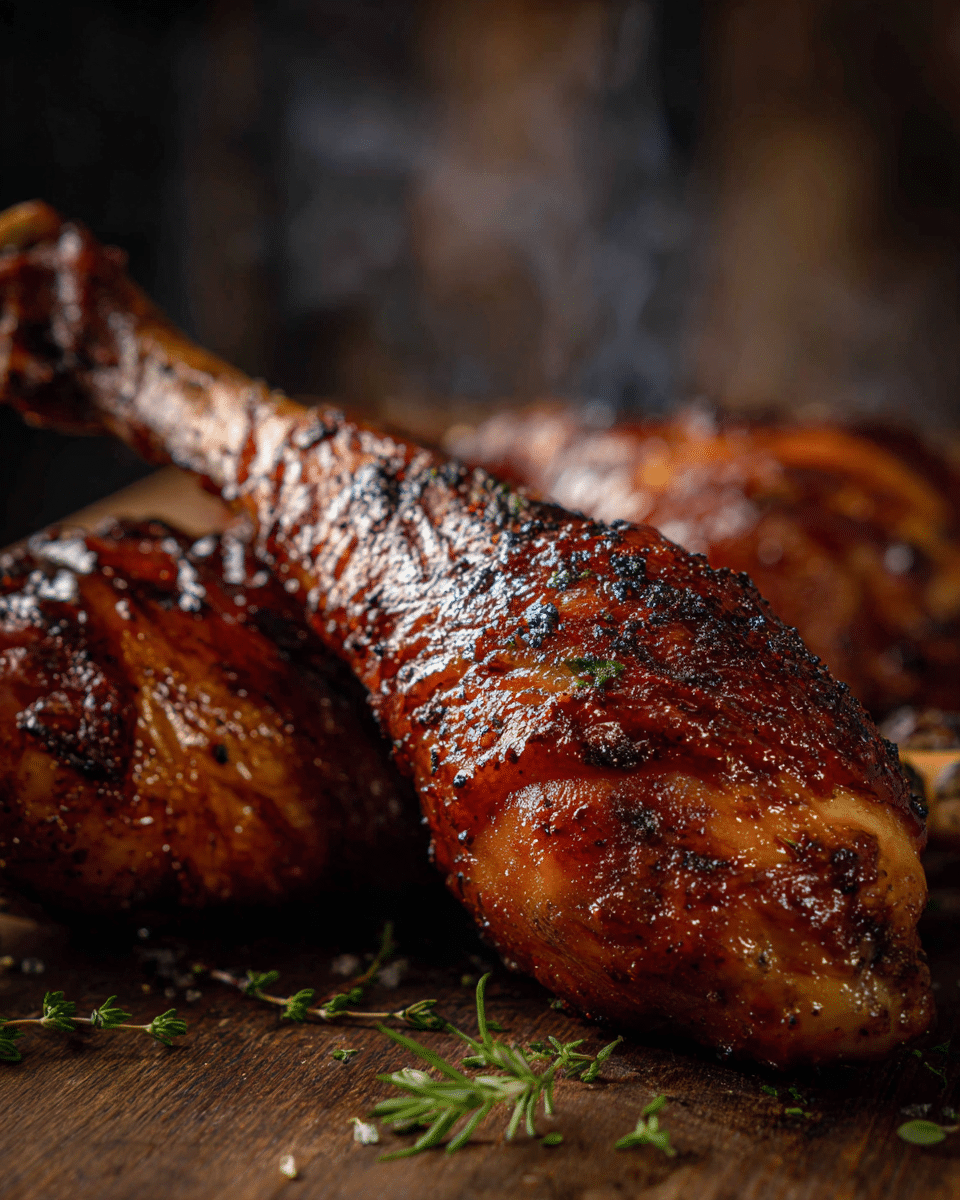Smoked turkey legs are the kind of meal that instantly transports you to a summer fair or a rustic backyard gathering. Juicy on the inside and kissed with applewood smoke on the outside, these drumsticks are packed with deep, savory flavor and are surprisingly simple to prepare—even for beginners.
The sweet and salty brine ensures tenderness, while a sticky layer of BBQ sauce caramelizes to perfection in the smoker. Whether you’re looking for an unforgettable Thanksgiving main or just an indulgent weekend BBQ centerpiece, these smoked turkey legs will steal the show. They’re also naturally gluten-free and easily customizable for paleo or dairy-free lifestyles.
Full recipe:
Ingredients:
Brine:
-
½ cup kosher salt (or 125g by weight)
-
¼ cup brown sugar (or coconut sugar for paleo)
-
2 bay leaves
-
1 tbsp whole black peppercorns
-
4 cups water
-
4 cups ice water
Turkey:
-
6 turkey legs
-
Olive oil
-
½ cup all-purpose BBQ rub
-
Applewood pellets (or cherry, hickory, or mesquite)
-
1 cup BBQ sauce
Directions:
Brine (Day Before):
-
In a large pot, combine water, salt, sugar, bay leaves, and peppercorns. Bring to a simmer, stirring to dissolve the salt and sugar.
-
Remove from heat and stir in ice water to cool.
-
Submerge turkey legs in a large container or brining bag with the cooled brine. Refrigerate 6–12 hours or overnight.
-
Remove turkey legs and pat dry.
Smoking (Day Of):
5. Rub legs with olive oil and coat with BBQ rub, pressing into the skin.
6. Preheat smoker to 225°F (107°C).
7. Place turkey legs directly on the smoker grates. Smoke until internal temp reaches 160°F (71°C), about 2–3 hours.
8. Increase smoker temp to 275°F (135°C). Brush legs with BBQ sauce. Continue smoking until internal temp reaches 175°F (79°C), 30–45 minutes.
9. Let rest for 20 minutes before serving.
Prep Time: 30 minutes | Cooking Time: 4 hours | Total Time: 11 hours 30 minutes
Kcal: 520 kcal | Servings: 6 servings
Why Brining Makes a Difference
The brining process is crucial to the success of this recipe. Turkey, especially the legs, can become dry or chewy if not properly handled, and the brine solves this problem with ease. A mixture of water, kosher salt, brown sugar, bay leaves, and peppercorns infuses the meat with moisture and subtle flavor over several hours.
This soaking not only tenderizes the turkey but ensures every bite is juicy and seasoned from the inside out. It’s a trick professional chefs and pitmasters swear by, and for good reason—it guarantees a succulent result, even after hours in a smoker. The added benefit of brining overnight is that it allows the turkey to absorb the flavors slowly, setting the stage for a flavorful and mouthwatering outcome.
The Role of the BBQ Rub
Once the turkey legs are removed from the brine and patted dry, a coating of olive oil helps the dry rub adhere properly to the skin. The BBQ rub used in this recipe is what gives the turkey that signature bark or crust on the outside—crispy, well-seasoned, and full of flavor.
The rub can be homemade or store-bought, depending on your preference, but it should have a balance of sweet, smoky, and spicy elements. Think paprika, brown sugar, garlic powder, onion powder, black pepper, and a hint of cayenne for heat. This seasoning blend not only enhances the smoky taste but also adds a rich color to the turkey legs during the cooking process.
Choosing the Right Wood for Smoking
The type of wood used in smoking makes a huge difference in the final flavor profile. Applewood, which is the recommended choice for this recipe, imparts a mild, sweet smoke that pairs perfectly with poultry. It’s subtle but impactful, allowing the flavor of the turkey and the seasoning to shine through.
Other good options include cherry wood, which adds a touch of fruitiness, hickory for a more robust and traditional BBQ flavor, or mesquite if you want a bold, earthy intensity. Each wood gives a slightly different finish to the meat, allowing you to experiment based on your flavor preferences.
Pellet grills or traditional smokers can both be used to achieve the desired result. What matters most is maintaining a consistent temperature and not rushing the process. Low and slow is the key.
Temperature Matters More Than Time
One of the most important aspects of smoking turkey legs (or any meat) is internal temperature. Rather than relying solely on time, using a good meat thermometer ensures that the turkey legs are fully cooked but not overdone. Turkey should be smoked until it reaches an internal temperature of 175°F (79°C). That’s the sweet spot for turkey legs—ensuring the collagen has broken down and the meat is tender but still juicy.
This process generally takes about 2–3 hours at 225°F (107°C), followed by a final increase in temperature to 275°F (135°C) for an additional 30–45 minutes to caramelize the BBQ sauce on the surface. The higher heat helps lock in the flavor and texture while creating a beautifully lacquered finish.
Finishing with BBQ Sauce
After the turkey legs have been slow-smoked to perfection, brushing them with BBQ sauce in the final stretch of cooking adds that extra level of flavor and stickiness that people love. The sauce caramelizes on the skin, mingling with the spices and smoke to form an irresistible glaze.
You can choose your favorite BBQ sauce—sweet, spicy, tangy, or smoky—or even make your own. Applying it in the final 30–45 minutes allows the sugars in the sauce to cook slowly and avoid burning, while still giving the turkey legs that glossy, finger-licking finish.
Serving and Presentation Tips
Smoked turkey legs are not only delicious—they’re visually impressive. Their large size and deep, rich color make them a centerpiece-worthy dish at any gathering. Serve them with classic BBQ sides like cornbread, baked beans, coleslaw, or grilled vegetables for a complete meal. If you’re aiming for a paleo or gluten-free meal, you can skip the BBQ sauce or use a compliant version.
For a casual gathering, you can even serve these legs as handheld fare—no utensils required. Their hearty nature makes them perfect for outdoor events, picnics, festivals, or game day spreads.
They also reheat well, making them a great option for meal prep. Simply wrap the leftover legs in foil and warm them in a low oven until heated through. You can even shred the leftover meat and use it in sandwiches, tacos, salads, or soups.
Variations and Substitutions
One of the best aspects of this recipe is its flexibility. You can switch up the brine to include citrus peels, fresh herbs, or garlic cloves for a different aromatic profile. The dry rub can be adjusted to suit your spice tolerance, and the sauce can range from mustard-based to molasses-rich depending on what you’re in the mood for.
If you don’t have access to a smoker, you can adapt this recipe for the oven or grill. Use indirect heat on the grill with wood chips wrapped in foil to create a smoky flavor. Or, roast the brined and seasoned turkey legs in a 300°F (150°C) oven for 2.5–3 hours until fully cooked and tender.
For a low-carb or keto-friendly version, be mindful of the sugar content in your rub and sauce—there are plenty of sugar-free options available to help keep things aligned with your dietary goals.
Health and Nutrition Benefits
Turkey is a great source of lean protein, and using turkey legs instead of dark red meats helps reduce saturated fat intake while still delivering a hearty, satisfying dish. This recipe is naturally gluten-free and can easily be made dairy-free or paleo with minimal modifications.
Using a dry rub and brine instead of deep frying or heavy marinades keeps the fat content in check while still offering bold flavor. It’s also a great option for those looking to serve a high-protein, crowd-pleasing dish that doesn’t rely on breading or frying.
The Ultimate Crowd-Pleaser
Smoked turkey legs bring people together. There’s something festive and primal about biting into a large, juicy drumstick—especially when it’s been slow-cooked to perfection with layers of flavor built over hours. Whether it’s a summer BBQ, fall harvest gathering, or Thanksgiving table, these turkey legs deliver on both taste and presentation.
They’re also a great conversation starter, especially when guests learn that they’ve been smoked from scratch. The process may seem complex at first glance, but it’s surprisingly approachable with the right preparation and tools.
Conclusion
Smoked turkey legs are more than just a meal—they’re an experience. With a few simple techniques like brining, rubbing, and smoking, you can turn an ordinary cut of meat into an extraordinary centerpiece. The key lies in balancing flavor, maintaining consistent temperatures, and giving the meat time to soak in all the goodness from the smoke and seasonings.
From fairs to festivals to your own backyard, this dish has long held a place in culinary tradition, and with this recipe, it can become a favorite in your household too. Whether you’re preparing for a special event or just trying something new, these smoked turkey legs are guaranteed to impress.
They’re flavorful, customizable, and surprisingly easy to pull off. So fire up the smoker, grab your favorite rub, and get ready to serve up one of the juiciest, most unforgettable meals you’ve ever made.






